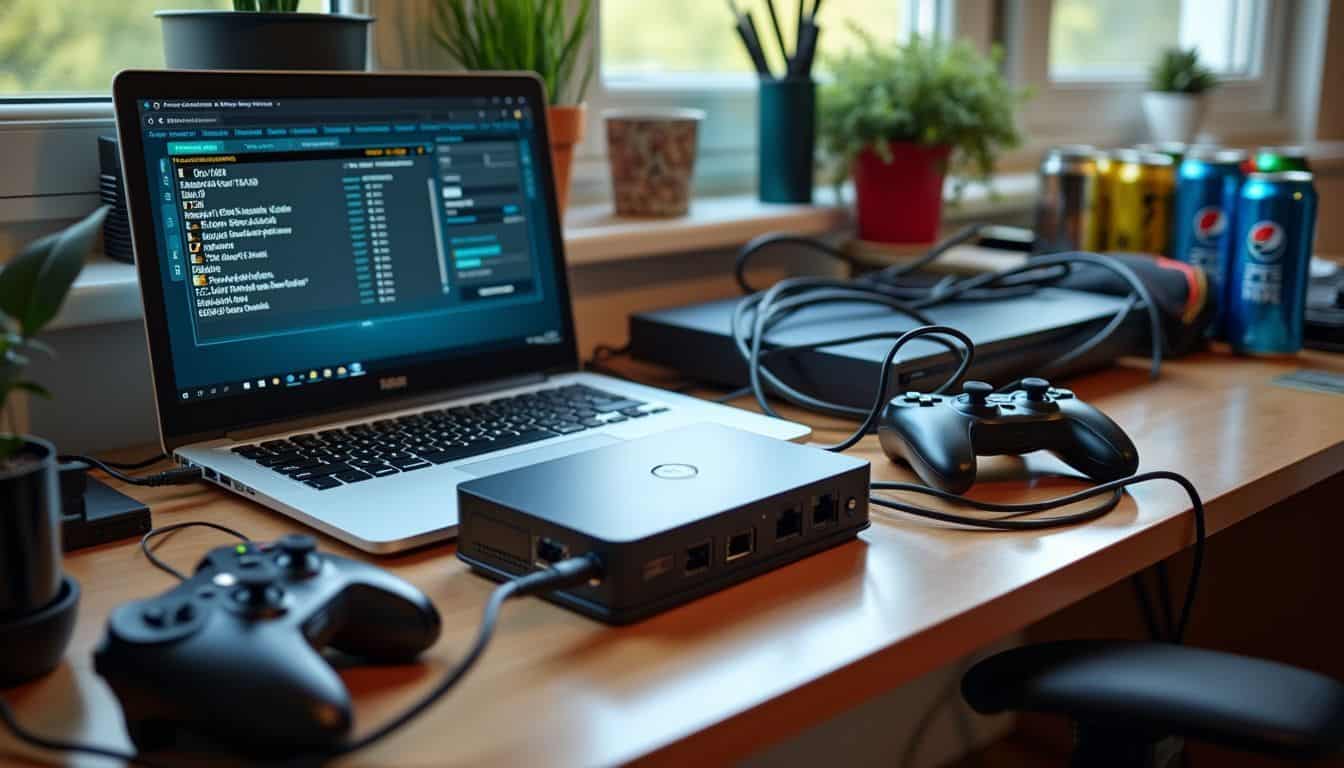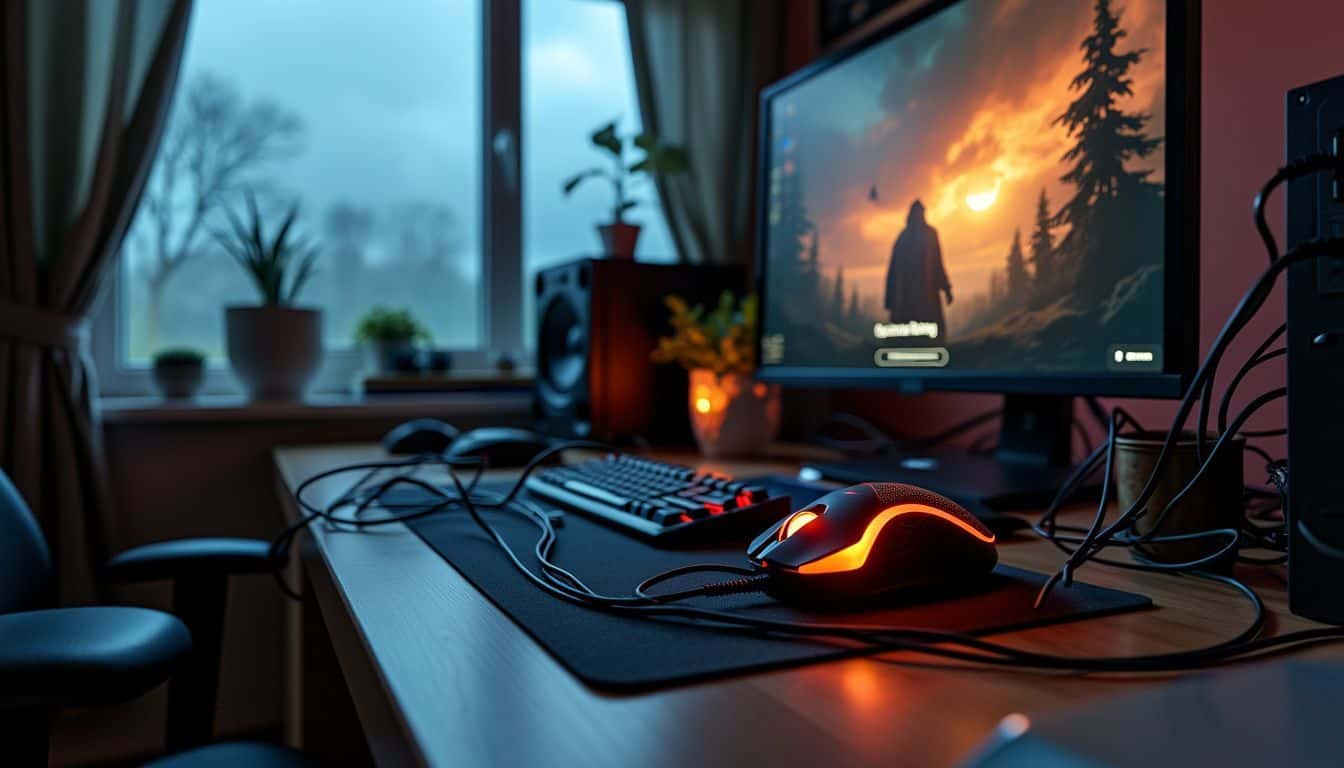Is lag ruining your gaming experience? You’re not alone. Slow internet can turn an epic battle into a frustrating mess. But don’t worry – we’ve got your back. This guide will show you how to get the best internet speed for gaming with seven lag-busting secrets.
Ready to level up?
Key Takeaways
Fast internet speed (at least 5 Mbps) and low latency (under 100 ms) are crucial for smooth gaming.
Wired connections beat Wi-Fi for gaming, offering faster speeds and more stable performance.
Updating router firmware, using QoS settings, and picking the right Wi-Fi channel can boost gaming speed.
Choosing the right ISP matters – fiber connections like Google Fiber offer high speeds (up to 8 Gbps) and low latency (11-14 ms).
Simple tricks like closing unused apps, playing during off-peak hours, and power cycling network devices can improve gaming performance.
Table of Contents
Key Internet Metrics Crucial for Gaming

Gaming speed isn’t just about fast downloads. It’s about a mix of factors that make your online play smooth and lag-free. Let’s dive into the metrics that’ll help you crush your opponents – not your connection.
Assessing Internet Speed

Internet speed is key for smooth gaming. You need to know your actual speeds, not just what your ISP promises. Run a speed test to check your download and upload rates. The FCC says you need at least 4 Mbps download speed for online play.
But let’s be real – that’s bare minimum. For a great experience, aim for 5 Mbps or more.
I’ve found that testing at different times of day gives a clearer picture. Peak hours can slow things down. Also, test both wired and wireless connections. Wired is usually faster and more stable.
If you’re not getting the speeds you’re paying for, it might be time to call your ISP or look into full fibre networks. As one pro gamer told me:
Speed tests are like a health check for your gaming setup. Don’t skip ’em if you want to stay on top of your game.
Evaluating Latency and Ping Rate

Now that you’ve checked your speed, let’s talk about latency in gaming and ping rate. These two factors can make or break your gaming experience.
Latency is the delay between your action and the game’s response. Ping rate measures this delay in milliseconds (ms). Lower numbers are better here, folks!
For smooth gameplay, aim for latency under 100 ms. Here’s a quick breakdown: 20 ms or less is top-notch. You won’t notice any lag. Between 20-50 ms? Still great – no issues. From 50-100 ms, you might see some lag now and then.
Once you hit 100-150 ms, lag becomes a real pain. Anything above 150 ms? Yikes! Your connection’s unstable, and you might even get booted from the game. I once played with 200 ms ping…
let’s just say my character moved like a drunk snail. Not fun!
Understanding Jitter and Packet Loss

Moving from ping rates, let’s talk about two more gaming gremlins: jitter and packet loss. These sneaky devils can wreak havoc on your gaming experience.
Jitter is like a hiccup in your internet connection. It’s the up-and-down time between data packets. Good gaming needs jitter under 30 milliseconds. Packet loss is when data bits get lost in transit.
It’s like your game info took a wrong turn and never made it home. For smooth gaming, you want packet loss in gaming to stay below 3-5%.
I once played a game with high jitter – my character looked like he was doing the robot dance! Not cool when you’re trying to snipe enemies.
Essential Hardware to Boost Gaming Speed

Got lag? Your hardware might be the culprit. Let’s talk about the gear that’ll supercharge your gaming setup – and no, it’s not just about that shiny new graphics card.
Selecting a High-Quality Router
Picking the right router can make or break your gaming experience. A top-notch router is like a traffic cop for your internet, directing data where it needs to go. New routers often come with Wi-Fi 6, which means faster speeds and less congestion.
Gaming routers are extra special – they’ve got tools built-in to make your games run smoother.
Don’t skimp on your router if you’re serious about gaming. Look for features like Quality of Service (QoS) that let you prioritize gaming traffic. Also, check for multiple antennas and dual-band capabilities.
These help spread your Wi-Fi signal better, especially if you plop the router in the middle of your home.
A good router is the unsung hero of online gaming.
Prioritize Wired Connections Over Wi-Fi
Geeks, listen up! Wired connections are the way to go for gaming. They’re like a superhighway for your data, zipping along without traffic jams. Wi-Fi? It’s more like a busy city street with stop signs and pedestrians.
Ethernet cables slash latency – that pesky delay between your actions and the game’s response. They’re your secret weapon for smoother gameplay and fewer rage-quits.
But wait, there’s more! Proximity to your router matters for Wi-Fi, but it’s not everything. Even top-notch gaming routers can’t match the speed of a good old Ethernet cable. Sure, they might boost your Wi-Fi game, but they’ll still lag behind wired connections.
So, if you’re serious about leveling up your gaming experience, plug in that cable and leave Wi-Fi in the dust.
Network Configuration Tips for Gamers

Ready to level up your gaming? Let’s dive into some network tweaks that’ll make your opponents wish they had your setup. From updating your router to fine-tuning QoS settings, these tips will help you crush lag and dominate online.
Update Your Router Firmware
Keeping your router’s firmware up-to-date is crucial for top-notch gaming performance. Fresh firmware can boost speed, fix bugs, and amp up security. Here’s how to update your router’s firmware like a pro:
- Find your router’s model number. It’s usually on the bottom or back of the device.
- Visit the manufacturer’s website. Look for a “Support” or “Downloads” section.
- Download the latest firmware. Make sure it matches your exact router model.
- Log into your router’s admin panel. Type your router’s IP address into a web browser.
- Locate the firmware update option. It’s often under “Administration” or “Advanced Settings.”
- Upload the new firmware file. Follow the on-screen prompts carefully.
- Wait for the update to finish. Don’t turn off your router during this process!
- Reboot your router. This step helps the new firmware take effect.
- Check if the update worked. Log back into the admin panel and look for the new version number.
- Set a reminder to check for updates. Aim to do this every few months for peak performance.
Implement Quality of Service (QoS) Settings
After updating your router’s firmware, it’s time to adjust its settings for better gaming performance. Quality of Service (QoS) can reduce lag and improve your gaming experience. Here’s how to set it up:
- Access your router’s control panel. Open a web browser and type in your router’s IP address.
- Find the QoS settings. Look for terms like “QoS,” “Traffic Control,” or “Bandwidth Management.”
- Enable QoS. Turn on this feature.
- Set up device priorities. Add your gaming console or PC to the high-priority list.
- Use your device’s MAC address. This unique code helps your router identify your gaming gear.
- Assign bandwidth limits. Give your gaming device most of your internet speed.
- Save and apply changes. Don’t forget this step, or your adjustments won’t stick!
- Test your new setup. Run a speed test to see if things have improved.
- Adjust as needed. If you’re still seeing lag, change your settings and try again.
QoS acts like a traffic cop for your home network. It ensures your gaming data gets the fast lane, leaving other devices in the slow lane. This can make a big difference in games where every millisecond counts!
Optimize Your Wi-Fi Channel and Band
Wi-Fi channels and bands can make or break your gaming experience. Let’s dive into some tricks to boost your signal and crush those lag spikes.
- Pick the right channel: Your router likely uses the 2.4GHz band, which has 11 channels. Channels 1, 6, and 11 don’t overlap, so they’re your best bet. Use a Wi-Fi analyzer app to see which channels are least crowded in your area.
- Switch to 5GHz: If your router supports it, the 5GHz band is less congested. It offers faster speeds but shorter range. Perfect for gaming if you’re close to your router.
- Auto-select feature: Some routers can pick the best channel automatically. Turn this on if you have it. It’ll save you the hassle of manual tweaking.
- Avoid interference: Keep your router away from microwaves, cordless phones, and baby monitors. These gadgets can mess with your Wi-Fi signal.
- Update router firmware: Fresh firmware can improve channel selection and overall performance. It’s like giving your router a brain boost.
- Try different locations: Move your router around. Sometimes, a few feet can make a big difference in signal strength.
- Consider a Wi-Fi extender: If you’re far from your router, an extender can help. It’ll boost your signal and might even offer better channel options.
- Use QoS settings: Quality of Service lets you prioritize gaming traffic. It’s like giving your game data a VIP pass through your network.
Selecting the Best Internet Service Provider (ISP)

Picking the right ISP can make or break your gaming experience. It’s not just about speed – reliability matters too. Want to know how to choose? Keep reading….
Compare Internet Speeds and Plans
Let’s get into the details of internet speeds and plans for gaming. Here’s a breakdown of some top providers and their offerings:
| Provider | Price Range (Monthly) | Speed Range |
|---|---|---|
| Google Fiber | $70.00–$150.00 | 1–8 Gbps |
| AT&T | $55.00–$250.00 | 300–5,000 Mbps |
| Verizon Home Internet | $49.99–$94.99 | 300–2,000 Mbps |
| CenturyLink | $30.00–$75.00 | 200–1,000 Mbps |
Google Fiber’s got the fastest speeds, but AT&T’s close behind. Verizon and CenturyLink offer solid options too. But speed isn’t everything – latency is crucial for gaming. Fiber connections, like EPB Fi-Speed, have low latency (11-14 ms) and no data caps. That’s perfect for gamers! When choosing a plan, think about your budget and gaming needs. Higher speeds cost more, but they’re worth it for serious gamers. Check out internet speed for gaming for more info. From my experience, anything above 100 Mbps usually works for most games. But if you’re into competitive gaming or streaming, go for higher speeds. Keep in mind, a stable connection is more important than raw speed!
Evaluate ISP Reliability and Customer Support
ISP reliability can make or break your gaming experience. Verizon FiOS, Xfinity, and AT&T Fiber stand out as top picks for gamers. These providers offer speedy connections and low latency – crucial for smooth gameplay.
Verizon Home Internet, for example, boasts an impressive average latency of just 13.28 ms. That’s lightning-fast!
But speed isn’t everything. Look for ISPs with solid customer support too. You’ll want help on hand if things go south mid-game. Also, unlimited data plans are a gamer’s best friend.
They let you play without fear of hitting data caps or dealing with throttled speeds. Trust me, nothing ruins a gaming session faster than suddenly slowing to a crawl because you’ve hit your data limit.
Practical Tips to Enhance Your Internet Speed and Performance

Want to level up your gaming speed? We’ve got some quick fixes that’ll make your internet zoom. Stick around for more lag-busting secrets!
Connect to the Closest Server
Connecting to the closest server is a game-changer for lag-free gaming. It’s like picking the shortest line at the grocery store – you get through faster! Your data travels less distance, cutting down on ping times.
This means smoother gameplay and quicker reactions in those intense multiplayer battles. I’ve seen my ping drop from 100ms to 20ms just by switching to a nearby server. It’s a night-and-day difference!
But how do you find these magical nearby servers? Most games have a server list or auto-connect feature. Pick the one with the lowest ping or closest to your location. If you’re using Steam, it often shows server locations right in the game menu.
For console gamers, check your network settings or the game’s multiplayer options. Now, let’s look at why playing during off-peak hours can give you an extra edge.
Play During Off-Peak Hours
After finding the best server, let’s talk about timing. Playing during off-peak hours is a smart move. It’s like driving on an empty highway – you’ll zoom along without traffic jams.
Late at night or early morning, fewer people use the internet. This means less network congestion. Your games will run smoother, with lower ping and less lag. It’s a simple trick that can make a big difference.
Plus, you might find more open servers and shorter queue times. So, night owls and early birds, you’ve got an edge in the gaming world!
Regularly Power Cycle Your Network Devices
Give your network devices a breather now and then. Restarting your modem and router can work wonders for your gaming experience. It’s like hitting the refresh button on your internet connection.
This simple trick can clear out any built-up data junk and reset your connection to the ISP. Plus, it might just fix those pesky lag issues you’ve been facing.
Don’t forget about your gaming console or PC, either. A quick reboot can solve many problems. It’s a good habit to power cycle all your network gear once a week. This keeps things running smoothly and might even boost your internet speed.
Next up, let’s talk about some advanced tricks to level up your gaming connection.
Shut Down Unnecessary Applications and Devices
Your gaming rig might be powerful, but it’s not the only thing using your internet. Other apps and gadgets can use up bandwidth like a hungry monster. Close them! Shut those Chrome tabs, pause your downloads, and turn off any devices you’re not using.
It’s like clearing the road for your game data to speed through. I once left Netflix running on my tablet while gaming – big mistake! My ping increased quickly. Now, I always do a quick device check before playing Overwatch or any multiplayer game.
Got family members streaming movies or browsing social media? That’s using up your valuable bandwidth too. Talk to them about scheduling heavy internet use around your gaming sessions.
It’s good for everyone: you get smoother gameplay, and they get to binge-watch without buffering later. Every bit of bandwidth is important when you’re trying to nail that perfect headshot or execute a quick move.
So, keep your internet clear for gaming!
Advanced Solutions for Improving Gaming Speed

Want to level up your gaming speed? Let’s dive into some pro tips. These tricks will boost your performance and leave lag in the dust.
Implement Port Forwarding
Port forwarding is a game-changer for hosting multiplayer servers. It’s like opening a secret door in your network, letting game traffic flow freely. But heads up – it’s not all fun and games.
Each title needs its own set of ports open. Call of Duty, Overwatch 2, and Diablo IV all have different requirements.
Here’s the kicker: port forwarding can leave your network exposed. It’s like leaving your front door unlocked. That’s where a VPN comes in handy. It’s your digital bodyguard, keeping the bad guys out while you play.
So, grab your controller and get ready to host like a pro – just don’t forget to lock up after.
Opt for a Wired Connection When Possible
Ditch the Wi-Fi and plug in, gamers! Wired connections are your secret weapon for smoother gameplay. They slash latency like a ninja, giving you lightning-fast reactions in-game. I’ve seen my ping drop from 50ms to a mere 10ms just by switching to Ethernet.
It’s like night and day!
Ethernet cables are your best friends for rock-solid gaming. They don’t suffer from Wi-Fi’s mood swings – no more signal drops or interference from your neighbor’s microwave. Plus, wired connections offer faster speeds and more stable performance.
Trust me, once you go wired, you’ll never want to go back to the laggy world of wireless gaming.
Consider Upgrading to Higher-Speed Internet Plans
Gamers, listen up! Your internet plan might be holding you back. Slow speeds can turn your epic battles into laggy nightmares. But here’s the good news: upgrading your plan could be the game-changer you need.
Speed Net Broadband offers air fiber plans up to 1 Gbps – that’s lightning-fast! With these speeds, you’ll blast through the recommended 3 Mbps minimum for gaming. Aim for 15 to 25 Mbps to really level up your play.
Don’t forget about latency – it’s just as crucial as speed. A ping rate below 150ms is decent, but 20ms? That’s pro-level stuff. Higher-speed plans often come with lower latency, giving you that split-second edge in multiplayer matches.
So, if you’re serious about gaming, it might be time to chat with your ISP about faster options. Your K/D ratio will thank you!
People Also Ask
What’s the secret sauce for zapping lag in online games?
The recipe for smooth gaming is simple: aim for low ping and high download speeds. Upgrade your internet package to at least 100 Mbps. Fiber internet is your best bet. Also, ditch Wi-Fi and plug in with a wired connection. It’s like swapping your rusty old bike for a sleek sports car!
How can I turbocharge my Wi-Fi for gaming?
First, give your router a spa day with firmware updates. Then, find its sweet spot away from walls and metal objects. If you’re still stuck in the slow lane, powerline adapters can be your highway to faster speeds. They turn your home’s electrical wiring into a speedy network backbone.
Does my computer need a tune-up for better gaming performance?
You bet! Keep your operating system and graphics drivers fresh as a daisy. Run virus detection software regularly to kick out uninvited guests. And don’t let cookies and targeted advertising hog your bandwidth. A clean PC is a happy gamer’s best friend.
What’s the deal with upload speeds for gaming?
Upload speed is the unsung hero of online gaming. It’s crucial for sending your moves to the game server. Aim for at least 5 Mbps to avoid those rage-inducing moments when your character freezes mid-punch. Remember, in the gaming world, every millisecond counts!
How do I choose between satellite and fiber internet for gaming?
If you have the choice, always go for fiber. It’s like comparing a cheetah to a sloth. Satellite internet suffers from high latency due to its journey to space and back. Fiber, on the other hand, zips data through cables at the speed of light. Your games will thank you!
Can cloud gaming services help with my internet speed woes?
Services like Xbox Cloud Gaming can be a game-changer if your home setup is struggling. They do the heavy lifting on their end, so you don’t need a beefy PC or lightning-fast connection. But remember, you’ll still need a stable internet connection to avoid a glitchy experience. It’s not a magic wand, but it can definitely help level the playing field!
References
https://www.highspeedinternet.com/resources/how-much-speed-do-i-need-for-online-gaming (2024-04-18)
https://www.americantv.com/guide-to-ping-and-latency-in-gaming.php
https://lightyear.ai/blogs/what-is-packet-loss-and-what-is-jitter-a-guide-to-isp-metrics-that-matter
https://www.broadbandsearch.net/blog/optimize-internet-setup-gaming (2024-05-31)
https://dongknows.com/gaming-router-explained/ (2024-02-24)
https://gigaclear.com/posts/how-reduce-lag-and-increase-internet-speed-gaming
https://www.youtube.com/watch?v=07FjRWYSDW8
https://www.youtube.com/watch?v=rxfc6SzM_FA
https://www.youtube.com/watch?v=8NzV_GGQdO4
https://www.highspeedinternet.com/resources/best-internet-for-gaming
https://www.youtube.com/watch?v=3QRP11kqdFs
https://community.spiceworks.com/t/what-do-you-consider-when-choosing-an-isp/409179
https://hypixel.net/threads/guide-how-to-improve-internet-speeds-and-lower-ping-in-2019-ultimate-guide.2290582/ (2019-08-31)
https://epb.com/get-connected/gig-internet/optimize-your-internet-for-gaming-to-reduce-lag/
https://usa.kaspersky.com/resource-center/preemptive-safety/how-to-improve-game-performance
https://surfshark.com/blog/port-forwarding-for-gaming
https://www.speednetlte.com/post/optimizing-your-internet-speed-for-gaming-what-you-need-to-know (2024-04-18)
